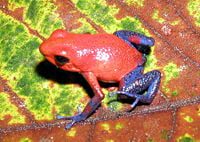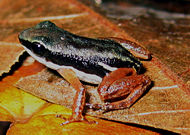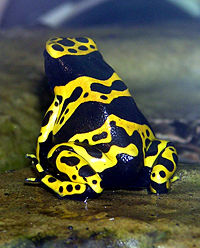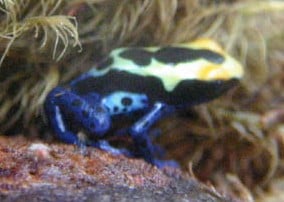Poison dart frog
| Poison dart frogs | ||||||||||||
|---|---|---|---|---|---|---|---|---|---|---|---|---|
 Red and Blue "Blue Jeans" Dendrobates pumilio Strawberry Poison Dart Frog
| ||||||||||||
| Scientific classification | ||||||||||||
| ||||||||||||
 Distribution of Dendrobatidae (in black)
|
Poison dart frog (also poison arrow frog, dart frog or poison frog) is the common name for any of the very small, diurnal frogs of the Dendrobatidae family . Their common name refers to the poisons contained within their skin which are used by local tribes to coat their blowgun darts. The family name Dendrobattidae and the genus name Dendrobates are derived from the Greek words : dendro (meaning tree) and bates (meaning walker); thus literally "tree walker" (Schlager 2003). Although the secretions from all of these frogs is poisonous , only a few species have enough poison to kill a human being (Patocka et al. 1999).
Even though many of these poison frogs are brightly colored with combinations of orange, blue , red ,yellow or black pigments , the majority are not brightly colored and are referred to as cryptically colored.
Taxonomy
The family Dendrobatidae consists of 164 species in 11 genera (Frost 2007) :
- Ameerega
- Colostethus
- Epipedobates
- Silverstoneia
- Adelphobates
- Dendrobates
- Minyobates
- Oophaga
- Phyllobates
- Ranitomeya
- Hyloxalus
General description

The adults are usually 0.5 to 2.5 inches in length from snout to anus , with most species 0.75 to 1.5 inches (Schlager 2003) or no larger than an adult human thumbnail. One of the largest of these is D. tinctorius,which can reach 2.5 inches (S.N.Z.P. 2007 ).
Male and female frogs look similar. The females are usually slightly longer. The easiest way to determine the sex of a particular species of poison dart frog is by observation in the wild. Mature male frogs will usually make a mating call after eating or after a heavy misting of water. The sound is similar to that of a series of high-pitched "clicks." In juvenile frogs the sex can sometimes be determined by the profile of the amphibian. The backs of males usually slope down with less of a break than females. Females are usually rounder and show a bigger break.
Another simpler way to sex these frogs is by their toes. A female dendrobate will have narrow toes all the way down and a male's toes get very wide at the ends. Sone mature males have a small section of grey skin on their neck.
Only a few of the poison frogs are brightly colored . Their skin may contain combinations of red,orange and blue skin pigments. Some have multiple bright colors with black stripes or spots . Others are green with black stripes or are mottled with black and yellow. Their coloration is very striking and does not blend into the surrounding vegetation. This is often referred to as warning coloration or aposematism. These brightly colored members of the Dendrobatidae have the most toxic skin ( Summers 2003).
Most members of the Dendrobatidae , such as those in the genus Colostethus , do not have brightly colored skin and are said to be cryptically colored , or able to hide and be camouflaged . The cryptically colored frogs do not contain as much skin toxins as the brightly colored frogs (Summers 2003).
Distribution
Poison dart frogs live primarily in the neotropical rainforests or cloud forests of Central and South America. Their homes range from as far north as Nicaragua and proceed southward to Costa Rica ,Panama and then as far south as southern Brazil and into Bolivia. Most species have a very small range in which they are found.
Some poison dart frogs live outside of Central and South America. Dendrobates auratus was transported to Oahu , Hawaii in 1932 by people and continues to thrive there . Some poison dart frogs are also found on the Caribbean island of Tobago (S.N.Z.P. 2007).
The cryptically colored poison dart frogs of the genus Colostethus, the largest genus , are usually found on the floor of the rainforest in the leaf litter near pools of water or a stream. Many of the brightly colored members such as the genus Dendrobates are usually found in trees or vines. D.auratus and D.tinctorius live at elevations below 2,600 feet and spend much of their time on the forest floor (S.N.Z.P. 2007).
Behavior and Reproduction
All of the poison arrow frogs have a diurnal lifestyle , which means they are more active during the day than at night. They become more noticeable earlier in the day rather than later. Anytime it rains they will become more conspicuous. Naturally these frogs are easier to observe during the rainy season than the dry season.
Mating usually occurs during the rainy season . Male frogs , in preparation for mating , will fight among themselves to establish their territory. Then each species will make their characteristic calls ,usually early in the morning at first daybreak (Schafer 1999) to attract mates . Surprisingly , in several members of the genus Colostethus, it is not the male but the female , that establishes the territory (Schlager 2003). In D. auratus , the females will protect their male and attack any other female that approaches.
In most species, eggs are laid on or near the forest floor , usually in a sheltered and moist spot. Typically the female lays infertile eggs and the male fertilizes them externally in a process called oviparity . The number of eggs laid (the clutch size) varies among genera. In the genus Colostethus the size will vary from 25 to 35 eggs. In the genus Dendrobates only 2 to 6 eggs will be laid (Schlager 2003). Once the eggs are laid and fertilized, one parent (generally the male) guards them until they hatch. Because female poison frogs are both extremely territorial and competitive, a parent must guard constantly its eggs in order to prevent a rival female from devouring them . The eggs will hatch in about two weeks.
The newly hatched tadpoles wriggle and climb onto the back of either the male or female parent, who transports them in a sticky mucous film to a slow moving stream or a small pool of water. This may be water trapped in the axil of a Bromeliad plant , a tree hole , the capsule of a Brazil nut, or some other type of water holding plant (Schlager 2003). Within the Dendrobate genus , the parents will transport the hatched tadpoles one at a time to their own separate pool of water.
Most species of dendrobatid tadpoles feed on aquatic plants such as algae , but those members of the genus Dendrobates are carnivores and must have meat. Dendrobate tadpoles will eat each other and must be raised isolated from each other . In these species, the female returns to the tadpoles about every 5 days to lay infertile eggs for them to feed upon ,these species are called 'obligate egg feeders' In a few species this is the only source of food for the tadpoles until they undergo metamorphosis into sub-adult froglets; . It takes about 6 weeks for the tadpoles to develop into adult frogs.
Toxicology
Poison frogs have been used since ancient times by the Embera and Noanama Choco tribes to provide poison for their blowgun darts.
The skin of the poison dart frogs has been found to contain almost 500 different lipophilic alkaloids spanning 20 different structural classes (Weldon et al. 2006). The types of toxins include batrachotoxins,pumilioxins,allopumiliotoxins ,homopumiliotoxins,epibatidine ,gephyrotoxins and histrionicotoxins. The most potent among these are the batrachotoxins and pumiliotoxins.
The most poisonous of all the poison dart frogs , Phyllobates terribilis, lives in the rainforests of the Cauca region of Colombia. It is considered by many to be the most poisonous animal in the world, with a very high concentration of batrachotoxin. The adult frog can secrete 700 to 1900 ug of batrachotoxin/homobatrachotoxin. Homobatrachotoxin is slightly less toxic than batrachotoxin. The minimum amount of this compound required to kill a 20 gram white mouse (lethal dose) , is only 0.05 micrograms subcutaneously (s.c.) (Patocka et al. 1999). This amounts to a level of 2.5 ug/kg . Thus it would take 125 ug to kill a 50 kg person ,assuming mice and human beings have the same sensitivity.
Another group of toxins that occur in the skin of the Dendrobatidae are the pumiliotoxins. They are known to occur in all members of the genera Dendrobates and Phyllobates. There are three types of pumiliotoxins : pumiliotoxin A,pumiliotoxin B and pumiliotoxin C. The least toxic of these is the C type. Pumiliotoxin A and B have s.c. toxicities in mice of about 1-3 mg/kg or about 1,000 times less toxic than batrachotoxin.
The poisonous alkaloids in the frog skin are categorized as neurotoxins. They affect nerves and muscles by causing an irreversible depolarization that blocks signal transmission. The depolarization is caused by opening the sodium channel and allowing sodium ions to rush into the cell and thus eliminating the resting membrane potential necessary for electrical transmission. This results in cardiac arrhythmia ,neuromuscular blockage and death. Batrachotoxin and pumiliotoxin act in slightly different way to achieve their neurotoxic effects.
It is thought that poison dart frogs don't actually manufacture any of the toxic alkaloids they use to defend themselves. In captivity, when the frogs are fed insects such as fruit flies and crickets that do not represent their diet in the wild , and are not rich in the required alkaloids, poison frogs stop producing toxins . In fact, many hobbyists and herpetologists have reported that most dart frogs will not consume any ants in captivity, though ants comprise the larger portion of their diet in the wild. Though all poison frogs lose their toxicity when deprived of certain foods, and captive bred poison frogs are born harmless, a poison frog ,caught in the wild , can retain alkaloids for years.
Dietary source of toxins
In New Guinea, the locals avoid eating birds of the Pitohui genus. Ingestion of this bird causes a numbing and burning sensation. Dr. Jack Dumbacher discovered that the skin and feathers of these birds contain batrachotoxin (Stone et al. 2004).
Some poison frogs not only absorb the alkaloids of the ants they consume, but also have the ability to chemically modify these toxins and thus create more toxic variants. For example, while Dendrobates auratus consumes pumiliotoxin 251D and merely stores it, some members of the Dendrobatidae family convert pumiliotoxin 251D to allopumiliotoxin 267A, which is five times more toxic than the original version.
Alhough they do not have the ability to produce these toxins, they do have a relationship with alkaloid-rich ants and other insects from which they obtain poisonous alkaloids such as pumiliotoxins or batrachotoxins.
Poison frogs are creatures of great scientific interest to evolutionary biologists. The frog's intriguing ability to resist, store, and manipulate toxins, along with its related role in the food chain, are among the most important discoveries in the study of food-chain evolution. Biologists have speculated that the frogs must have first evolved a resistance to the alkaloids in response to using the ants as a food source. The ability to digest even toxic foods allowed them capitalize on an otherwise-untouched food source, a fairly common event on the evolutionary scale. Once having developed a resistance to such foods over the course of countless generations, any genetic variation that happened to make the ingested poison accumulate closer to the skin's surface would have bestowed a greater advantage with each beneficial mutation. Secreting this new weapon, they would have then evolved their bright colors and adapted to a diurnal schedule in response to the absence of natural predators, and some frogs would go as far as to evolve the ability to manipulate the toxins they consumed, thus increasing their deterrence to predators and their likelihood to survive.
Poison frogs in captivity
In captivity, poison dart frogs have a lifespan of 5 to 12+ years, but little data exists for wild frogs. Poison dart frogs are commonly bred in captivity to be non-toxic. Most species reach maturity around 1.5 to 2.5 years of age.
In captivity, most species thrive where the humidity is kept constant at 80-100% and where the temperature is around 75-80 F degrees (24-27 °C) during the day and no lower than 60-65 F degrees (16-18 °C) at night.
Color morphs
Some species include a number of sub-species 'morphs'. Different morphs represent geographically separated populations of the same species in the wild, showing different coloration. For example, the species Dendrobates tinctorius includes at least a dozen morphs.
ReferencesISBN links support NWE through referral fees
- Frost, D. R. 2007. Amphibian Species of the World: an online reference. Version 5.1 . Electronic Database accessible at [1] American Museum of Natural History, New York, USA. Retrieved September 29, 2007.
- Grant , Taran; Frost, Darrel R.; Caldwell, Janalee P.; Gagliardo, Ron; Haddad, Celio F.B.; Kok, Philippe J.R.; Means, D. Bruce; Noonan, Brice P.; Schargel, Walter E. & Wheeler, Ward (2006): Phylogenetic systematics of dart-poison frogs and their relatives (Amphibia, Athesphatanura, Dendrobatidae). Bulletin of the American Museum of Natural History 299: 1-262. PDF fulltext Retrieved September 29, 2007.
- Stone,S.G. and P.Kilduff. 2004. New Research Shows that Toxic Birds and Poison-dart Frogs Likely Acquire their Toxins from Beetles :Academy Scientist Dr. Jack Dumbacher Finds Elusive Toxin Source in New Guinea.[2]accessed on 10-20-2007
- Patocka ,J., K. Schwanhaeuser Wulff and M. Marini Palomeque. 1999. Dart Poison Frogs and Their Toxins . The ASA Newsletter,ed. R. Price.ISSN 1057-9419.[3]accessed on 10-20-2007
- Schafer ,R. 1999. Dendrobates auratus.Animal Diversity Web.[4]. accessed on Oct 22,2007
- Schlager,N.(ed.). 2003 . Poison Frogs (Dendrobatidae) .pp. 197 - 210. Amphibians ,Vol. 6. Grzimek's Animal Life Encyclopedia,second edition. Detroit: Thomson Gale publishing .
- S.N.Z.P. (Smithsonian National Zoological Park). 2007.[5]accessed on 10-22-07
- Summers , K. 2003. Convergent Evolution of Bright coloration and toxicity in frogs. Proc. Nat. Acad. Sci. 100 (22): 12533-12534.
- Weldon,P.J.,M.Kramer,S. Gordon,T.F. Spande and J.W.Daly. 2006. A common pumiliotoxin from poison frogs exhibits enatioselective toxicity against mosquitoes. P.N.A.S. 103(47):17818 - 17821.
OTHER ARTICLE
P.terribilis and other poison frogs natural history http://www.herpetologic.net/frogs/caresheets/terribilis.html
COLOR PHOTOS OF POISON DART FROGS AND ARTICLE ON TYPES OF POISON PRODUCED [6]
| Chordata - Amphibia - Families of Anura | |
|---|---|
|
Allophrynidae - Amphignathodontidae - Arthroleptidae - Ascaphidae - Bombinatoridae - Brachycephalidae - Bufonidae - Centrolenidae - Dendrobatidae - Discoglossidae - Heleophrynidae - Hemisotidae - Hylidae - Hyperoliidae - Leiopelmatidae - Leptodactylidae - Mantellidae - Megophryidae - Microhylidae - Myobatrachidae - Nasikabatrachidae - Pelobatidae - Pelodytidae - Pipidae - Ranidae - Rhacophoridae - Rhinodermatidae - Rhinophrynidae - Scaphiopodidae - Sooglossidae | |
Credits
New World Encyclopedia writers and editors rewrote and completed the Wikipedia article in accordance with New World Encyclopedia standards. This article abides by terms of the Creative Commons CC-by-sa 3.0 License (CC-by-sa), which may be used and disseminated with proper attribution. Credit is due under the terms of this license that can reference both the New World Encyclopedia contributors and the selfless volunteer contributors of the Wikimedia Foundation. To cite this article click here for a list of acceptable citing formats.The history of earlier contributions by wikipedians is accessible to researchers here:
The history of this article since it was imported to New World Encyclopedia:
Note: Some restrictions may apply to use of individual images which are separately licensed.

